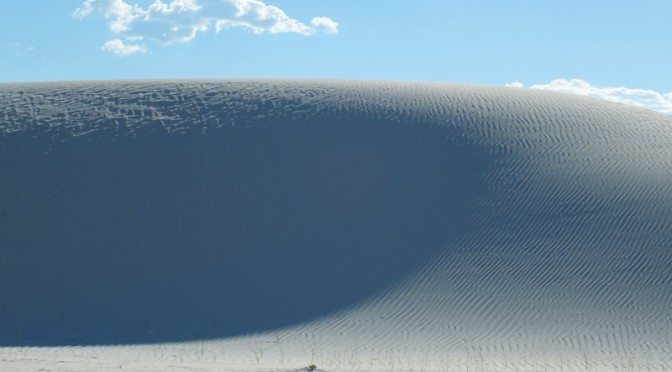Talk about surreal — the landscape of the White Sands National Monument sneaks up quickly as you drive into the park on the main scenic route — a sixteen mile in-and-out trip. Many people see the term “National Monument” and expect to see a marker or a statue when they arrive, but that is a misnomer. The stated difference is that a national park recognizes an “outstanding scenic feature or natural phenomena” while a national monument contains “objects of historic, prehistoric, or scientific interest”. I have to say that the distinction is often lost on me when I’m on the ground.

There is no significant marker or monument to see at White Sands and I would probably describe it more as a scenic natural phenomena than any of the other words. I’ve often suspected that the park/monument delineation is more about arcane politics than any significant difference. Both kinds of parks are almost always cool places.
 White Sands is about 275 square miles of pure white gypsum dunes that take on the appearance of massive gently rolling waves. Located in south-central New Mexico, the park is situated in a broad valley (known as the Tularosa Basin) between two lines of mountains that run from north to south. The White Sands Missile Range, a huge testing area for military hardware surrounds the park and makes it feel even more isolated and remote.
White Sands is about 275 square miles of pure white gypsum dunes that take on the appearance of massive gently rolling waves. Located in south-central New Mexico, the park is situated in a broad valley (known as the Tularosa Basin) between two lines of mountains that run from north to south. The White Sands Missile Range, a huge testing area for military hardware surrounds the park and makes it feel even more isolated and remote.
 As you leave the highway and head on the scenic route toward the dunes the look changes from scrubby desert to white sand with swatches of grass protruding through hear and there. The height of the dunes increase and the vegetation decreases as you go deeper. Eventually, everything is white except for the blue sky — the dunes can be quite high and the route snaking between them quite narrow. The road itself has turned from pavement into a solid, white sand structure.
As you leave the highway and head on the scenic route toward the dunes the look changes from scrubby desert to white sand with swatches of grass protruding through hear and there. The height of the dunes increase and the vegetation decreases as you go deeper. Eventually, everything is white except for the blue sky — the dunes can be quite high and the route snaking between them quite narrow. The road itself has turned from pavement into a solid, white sand structure.
Time seems to be suspended sitting on a dune with a stillness that almost seems to be shouting — it is so different than what I am normally doing.









Leave a Reply